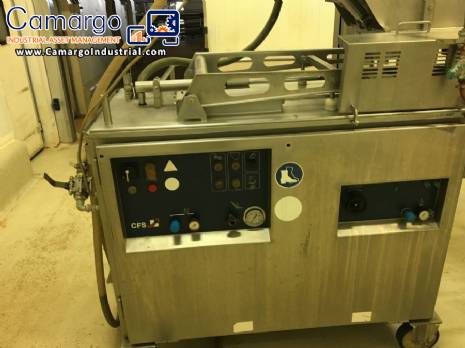Pre-dusters are industrial equipment used in the pre-breading process, which aims to prepare food for the final breading (breader). The pre-duster applies a thin layer of flour or dry mix to the food, usually before it is coated in a liquid layer and then a final layer of breading. This initial process helps to improve the adhesion of the liquid layer (such as egg or batter) to the food and contributes to a crispier and more consistent crust after frying or baking.
The main function of the pre-duster is to prepare the food for the final breading by applying a light layer of flour or dry mix, such as wheat flour, cornstarch or breadcrumbs. This process helps to create a surface that allows the liquid layer, such as beaten egg or batter mix, to stick better to the product and, therefore, the breader or breadcrumb layer adheres more evenly and effectively.
Pre-dusting process:
The pre-dusting process involves applying a coating of flour or other dry mix to food products, such as meat, chicken, fish or vegetables, before passing them through a liquid coating (usually egg or batter) and then through a coating of breadcrumbs or other dry coating.
Steps of the pre-dusting process:
- Food preparation: The food, such as pieces of meat or chicken, is first cut and sometimes seasoned.
- Pre-dusting (dry flouring): The food is passed through a thin layer of flour or other dry mix. This helps dry the surface of the food, allowing the liquid coating (such as egg or batter) to adhere better to the surface.
- Liquid coating: After pre-dusting, the food is passed through a liquid coating (such as beaten egg or batter mixture), which will allow the breading (breadcrumbs, panko or other flour) to adhere more easily.
- Final coating: The food is now coated with the breading (breadcrumbs or other breading) and is ready to be fried or baked.
Types of pre-duster flour applicators:
There are different types of pre-duster flour applicators, each suited to different types of food and production volumes. Some of the most common types include:
- Vibratory pre-duster flour applicators:
This type of applicator uses a vibratory system to distribute the flour evenly over the food. This ensures a thin, consistent coating without wasting any flour.
- Rotary pre-duster flour applicators:
The rotary system applies the flour to the food while it is rotated or moved on a drum or belt. This type of system is effective for products that require a more even application of flour.
- Spray pre-duster flour applicators:
In some models, the flour is sprayed directly onto the food, which helps to create a thin, precise coating. This is particularly useful when working with large volumes of food or when looking for a lighter coating.
- Continuous pre-duster flour applicators:
These systems operate continuously, allowing large quantities of food products to be pre-breaded quickly, without the need for frequent stops.
Advantages of the pre-duster flour applicator:
- Improves adhesion of the liquid layer:
The main advantage of the pre-duster is that it improves the adhesion of the liquid layer (such as egg or batter) to the food, which makes it easier to apply the final coating and contributes to a more consistent and crispy crust.
- Reduced flour waste:
As the applicator distributes the flour in a controlled and uniform manner, the waste of flour or dry mix is significantly reduced, making the process more economical.
- Uniformity in breading:
Using a pre-duster applicator ensures that all foods receive the same dry flour coating, promoting a more uniform and higher quality breading.
- Increased efficiency:
Automating the pre-dusting process increases production speed and consistency, allowing large volumes of food to be processed quickly.
- Improved end-product quality:
The pre-dusting process results in a crispier and more consistent crust on the final product, which improves the consumer experience.
- Reduced manual intervention:
Automating the pre-dusting process reduces the need for manual intervention, which improves food safety and operational efficiency.
Industries that use pre-duster flour applicators:
Pre-duster flour applicators are primarily used in food industries that produce breaded or processed foods. Some of the industries that benefit most from this equipment include:
- Frozen food industries:
Manufacturers of frozen foods, such as chicken nuggets, breaded fillets, breaded fish, and other food products, use pre-duster flour applicators to optimize breading.
- Fast food industries and restaurant chains:
Large fast food chains, such as restaurants that serve fried chicken or breaded fish, use pre-duster flour applicators to improve breading adhesion and increase productivity.
- Meat and fish processing industries:
Companies that process meat, fish, and seafood, including products such as breaded or fried fillets, also use pre-duster flour applicators to ensure uniform breading.
- Ready-to-eat food industries:
Manufacturers of ready-to-eat and frozen meals, which include breaded foods as part of their dishes, also benefit from pre-duster flour applicators to improve the quality of the breading.
- Vegetarian or alternative food industries:
Companies that produce vegetarian products, such as plant-based burgers or breaded tofu, also use pre-duster flour applicators to bread these products evenly and efficiently.
In short, pre-duster flour applicators play an important role in the breading process, helping to ensure a consistent and crispy breading layer. With the ability to evenly distribute a layer of flour or dry mix over food, they increase efficiency, improve the quality of the final product and reduce ingredient waste. Industries such as frozen food, fast food, meat and fish processing, and ready-to-eat food are major users of these machines. |




